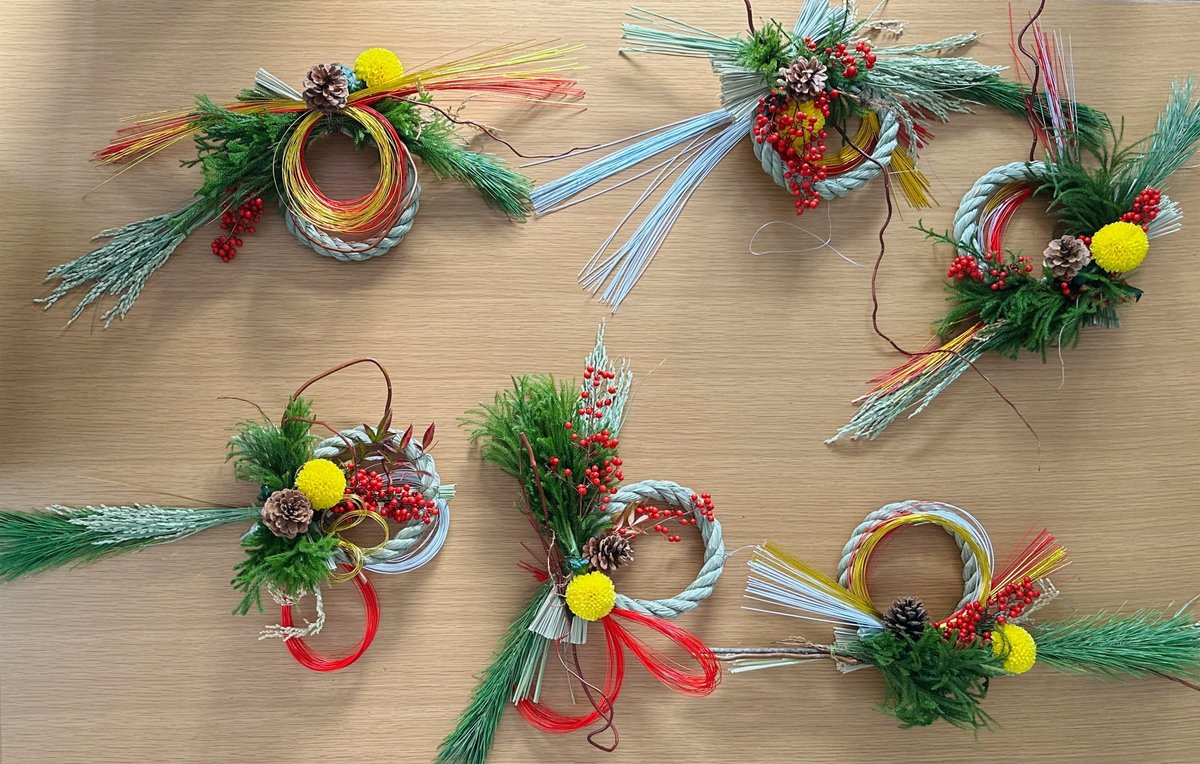
しめ縄飾りの材料になる植物は・・・
クリスマスが終わると一気にお正月が目の前に見えてきます。日本中の雰囲気が和風に一変する週がやってきました。
毎年思うのですが、日本全国様変わりナンバーワンの日は、本日、12月26日だと感じています。笑
昨日まではクリスマスらしいキラキラした洋風な装飾だったのに、今日から全国一気にお正月モード。
実は花屋ではすでに数週間ほど前からじわじわとお正月花を準備しており、松もとっくに仕入れ済み。クリスマスが終わると同時にポインセチアやヒイラギが店頭から姿を消し、代わりにいつ揃えたの?って驚くような量の松や千両、菊、葉牡丹などが店先にドーンと登場します。
ばら売りのお正月花だけでなく、花屋によっては、お正月用のお飾りを販売しているのを目にします。その代表格が、しめ縄飾り。皆さんも毎年玄関にしめ縄を飾っていますか?
私たち日本人の風習になっているこのしめ縄、一体何のアイテムが付いているのか、そしてどんな意味があるのか、はたまた土台になっている縄は何でできているのか、などなど、あまり意識をしてこなかった方も多いのではないでしょうか。それだけ日本人にとってしめ縄飾りは「当たり前」になって
いますからね。
縄に使われている植物は、稲わら、麻、真菰(まこも)などがあります。稲作が伝わって以来、稲は縄文時代から身近な存在ですし、「縄文」という名のとおり、縄をなう文化は古くから根付いてきました。
では、しめ縄を飾るようになった由来は何か、というと、『古事記』にある天の岩戸の神話が元になっているそうです。洞窟の中に篭ってしまった天照大神が外に出てきた際、また岩戸の中に戻れないように岩に縄を張りめぐらせた、という伝説です。
また、しめ縄が蛇を意味する、という説もあります。しめ縄は2匹の蛇がからまっている、つまり交尾をしている姿、ではないか、と。日本では古くから蛇信仰があり、それこそ縄文土器にも蛇の模様が描かれていたりもします。蛇をまつる神社が各地に存在し、しめ縄自体が蛇を表している、という例も少なくありません。これまた『古事記』ですが、ヤマタノオロチの神話では、蛇は人に災いをもたらすものとして描かれています。それも自然に対する畏怖の念からできたストーリーだったのかもしれません。いずれにせよ、脱皮を繰り返す蛇は死と再生の象徴として、神格化されていったのでしょう。
さて、しめ縄飾りにはどんな意味があるのでしょう。しめ縄飾りは、お正月に歳神様をお迎えする際の目印となるもの。しめ縄飾りを目印として歳神様が各家庭にいらしてくださるのです。また、邪悪なものから家を守るという意味もあります。古えでは、しめ縄を家の周りに張り巡らせて邪気を払っていたそう。それがだんだん形を変えて、縁起物の数々のお飾りを付け、玄関に飾る現代のしめ縄飾りになったのです。
ichirinのお教室では、いけばなの生徒さんたちもリースの会の皆さんも、ごちゃ混ぜになって年末にしめ縄飾りのワークショップをします。
昨年から岩手出身の友人が、お父様の田んぼからたわわになった稲を持ってきてくれるようになり、更にあたたかで意味深いしめ縄飾りが作れるようになりました。ただただご縁に感謝しかありません♡。来年は、縄をなうところから作りたいな、と考えています。(縄をなう方法をプロから学んだので!)


さて、今回はしめ縄材料の代表であるイネの花言葉をお届けしましょう。「神聖」です。
命を繋ぐ大切な穀物のイネ。新年を迎えるにあたって、清らかな気持ちになる花言葉ですね。今年もじわじわとご縁が拡がり、メルマガ読者がかなり増えました。皆様に読んでいただき、ありがとうの気持ちでいっぱいです。皆さんも、どうぞあたたかく穏やかな年末年始をお過ごしください。次回のメルマガは年明けになります。そういえば、蛇蛇言っていて、来年は巳年ではないですか!いい具合にオチがつきましたね。笑
【編集後記🥀】演劇のワークショップを観に行きました。参加者たちは舞台俳優の卵さんと思しき方々。舞台上の役者同士のコミュニケーションの在り方を伝えようとしていた主催者の一言が刺さりました。「自分と相手の間にある目に見えないものの存在が大事」と。それは私たちの普段の人間関係にも当てはまりますね。そして、いけばなも同じだなぁ、と思いました。花と花の間、花と人の間、に在るものが大事なんです、はい。
As Christmas passes, the New Year quickly comes into sight. This is the week when the atmosphere across Japan suddenly turns traditional and distinctly Japanese.
【Ichirin’s Floral Note 🌸 Which Plants Are Used in Shimenawa Decorations?】
Every year, I can’t help but feel that December 26 is the day when Japan undergoes the most dramatic transformation. Just yesterday, Christmas lights and Western-style decorations adorned the streets, but today, the country switches entirely to New Year’s mode.
At florists, the transition has been quietly brewing for a few weeks. New Year’s flowers like pine branches have long been in stock, and as soon as Christmas ends, poinsettias and holly disappear from storefronts, replaced by abundant displays of pine, senryo, chrysanthemums, and ornamental cabbages.
Beyond individual New Year’s flowers, some florists sell ready-made decorations for the season, with shimenawa (traditional straw ropes) being a standout example. Do you hang a shimenawa on your door every year?
For many of us in Japan, shimenawa have become such an ingrained custom that we may not stop to consider what they’re made of, what their attached decorations signify, or what the rope itself represents. Let’s take a moment to reflect on these details.
The rope used in shimenawa is often made from materials such as rice straw, hemp, or makomo (manchurian wild rice). Rice, introduced with ancient farming practices, has been central to Japanese culture since the Jomon era. In fact, the word “Jomon” itself is derived from “rope patterns,” highlighting how deeply woven rope-making traditions are in Japan.
The origins of the shimenawa tradition trace back to the legend of the Sun Goddess Amaterasu from the Kojiki (Japan’s oldest historical record). According to the story, when Amaterasu emerged from the cave where she had hidden, a rope was placed across the entrance to prevent her from retreating. This myth forms the basis of why shimenawa are used to mark sacred spaces.
There’s also a theory that shimenawa symbolize snakes. Some believe the intertwined rope resembles two snakes mating. Snake worship has ancient roots in Japan, with snake motifs appearing on Jomon pottery and numerous shrines dedicated to snakes across the country. In the Kojiki, the eight-headed serpent Yamata-no-Orochi represents calamity. However, snakes—with their cyclical shedding—also symbolize death and rebirth, eventually being deified as sacred beings.
Shimenawa decorations serve as markers to welcome the New Year deity, Toshigami-sama, into one’s home. They also act as a protective barrier against evil spirits. In ancient times, shimenawa encircled entire homes to ward off malevolent forces, a practice that evolved into today’s smaller, ornamental versions adorned with auspicious decorations and placed on doorways.
At Ichirin’s classes, our ikebana students and wreath-making attendees come together for an end-of-year shimenawa workshop. Since last year, a friend from Iwate has been generously providing rice straw from her father’s rice fields, allowing us to create even more meaningful and heartfelt decorations. I’m truly grateful for this connection. Next year, I’m planning to take it a step further and incorporate the process of rope-making from scratch, as I recently learned the technique from a professional.


For this edition, let me share the flower language of rice, a key material in shimenawa: "Sacredness." As an essential grain that sustains life, rice’s flower language feels particularly fitting for welcoming the New Year with a pure and serene heart.
This year, our circle of connections has steadily grown, and the number of newsletter readers has increased significantly. I’m deeply thankful for each of you who takes the time to read this.
May you enjoy a warm and peaceful end to the year. Our next newsletter will be in the New Year. Speaking of which, after all this talk about snakes, isn’t 2025 the Year of the Snake? What a serendipitous conclusion!
【Afterword 🪷】
I recently attended a theater workshop featuring aspiring stage actors. The organizer, attempting to convey the importance of onstage communication, said something that struck me: “What matters is the invisible connection between you and your partner.” This sentiment, I realized, applies to our daily human relationships as well as to ikebana. The space between flowers, and the connection between flowers and people, are equally significant.
🌿🌿🌿🌿🌿🌿🌿🌿🌿🌿🌿🌿🌿🌿🌿🌿🌿🌿🌿🌿🌿🌿🌿🌿🌿🌿🌿🌿🌿🌿🌿🌿🌿🌿
ichirinフラワーアレンジメントスクール・龍生派一綸いけばな教室 受講者募集中!
いずれもオンラインレッスン・対面レッスンがあります。
フラワーアレンジメント教室は、「ウェルカムリースの会」として、リニューアルしました!季節のお花を楽しむ会なので、興味のある回に単発で参加も可能です。

いけばな教室はコース仕立てなので、効率的・計画的に実力をつけていけます。龍生派のお免状も取得できるいけばな専門のコースです。(対面6,000円、オンライン9,000円/回)また、自分のペースでのんびり学びたいという方ももちろんOK!(月に1回〜)。お気軽に体験レッスンもできます。

一綸いけばな教室のウェブサイトは以下のリンクからご覧いただけます。
https://ichirin-ikebana.com/
🌿🌿🌿🌿🌿🌿🌿🌿🌿🌿🌿🌿🌿🌿🌿🌿🌿🌿🌿🌿🌿🌿🌿🌿🌿🌿🌿🌿🌿🌿🌿🌿🌿🌿
ichirin代表大澤尚子の活動情報はこちら。
・ichirinウェルカムリースの会
・ネットショップ:ichirin’s STORE
・Instagram(アレンジメント、リース、スワッグ):ichirin (@hanasakka.ichirin)
・Instagram(いけばな):大澤 尚子 (@ichirin_naoko)

